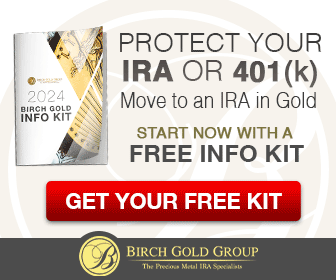Gold IRA Rollover: **Steps to Transfer Retirement Funds into a Gold IRA**
**Steps to Transfer Retirement Funds into a Gold IRA**
As someone deeply interested in retirement planning and seeking ways to diversify, I have explored various investment options, and one that particularly caught my attention is the Gold IRA. In this article, I will share valuable insights on how to transfer retirement funds into a Gold IRA, highlighting its attributes, eligibility criteria, the rollover process, tax implications, potential pitfalls to avoid, and much more.
1. Introduction
Retirement planning is a critical aspect of financial stability, and diversification is key. A Gold IRA has traditionally provided investors with a unique avenue to diversify their retirement funds by investing in precious metals. Remember, this article is not intended to act as a substitute for investment advice. Always consult with a licensed professional advisor before making any investment decisions.
2. What is a Gold IRA?
A Gold IRA, also known as a Precious Metals IRA, is a self-directed individual retirement account that allows you to invest in IRS-approved precious metals, such as gold, silver, platinum, and palladium, instead of traditional assets like stocks and bonds.
3. Attributes of a Gold IRA
Diversification of Retirement Portfolio
Including precious metals in your retirement portfolio provides additional diversification, managing the overall risk associated with market fluctuations and economic uncertainties.
Hedge Against Inflation
Gold has historically served as a hedge against inflation, insulating overall retirement portfolios even in times of rising prices.
Insulation in Economic Uncertainty
During times of economic instability, precious metals have traditionally retained steady value, offering a solid option for investors looking to manage portfolio risk.
4. Eligibility for Gold IRA Rollover
Transferring funds into a Gold IRA is possible from various retirement accounts:
Traditional IRA to Gold IRA Rollover
If you have a Traditional IRA, you can initiate a rollover to move funds into a Gold IRA without incurring penalties.
401(k) to Gold IRA Rollover
Rolling over a 401(k) into a Gold IRA is an option when changing jobs or retiring. It offers tax advantages and allows for better control over investment choices.
Other Retirement Accounts
Depending on your specific retirement plan, you might be eligible to roll over funds into a Gold IRA from other accounts.
5. Choosing a Reputable Gold IRA Custodian
Selecting a trustworthy and experienced custodian is crucial for the success of your Gold IRA. Research and compare various custodians to find the one that best aligns with your needs and goals.
6. Types of Precious Metals Allowed in a Gold IRA
A Gold IRA allows investment in several precious metals:
Gold
Gold, the primary choice for many investors, has been viewed as a store of value for centuries.
Silver
Silver is another popular option, typically being less expensive than gold.
Platinum
Platinum provides diversification and is in demand for industrial purposes.
Palladium
Palladium offers exposure to the automotive and technology industries.
7. Gold IRA Rollover Process
Transferring retirement funds into a Gold IRA involves several essential steps:
Research and Education
Educate yourself about the intricacies of a Gold IRA, precious metals, and potential risks.
Selecting the Right Custodian
Choose a reputable custodian that specializes in precious metals IRAs and aligns with your investment goals.
Opening a Gold IRA Account
Once you’ve chosen a custodian, open a new Gold IRA account.
Funding the Gold IRA
Transfer funds from your existing retirement account into the newly opened Gold IRA.
Purchasing Precious Metals
Work with your custodian to select and purchase IRS-approved precious metals for your Gold IRA.
8. Potential Pitfalls to Avoid
Navigating a Gold IRA rollover requires attention to certain risks:
Unscrupulous Dealers
Beware of fraudulent gold dealers; work with reputable and accredited sources.
IRS Regulations and Penalties
Stay informed about IRS regulations to avoid penalties and potential disqualifications.
Timing Considerations
Timing is crucial when transferring funds to maximize investment opportunities.
9. Tax Implications of Gold IRA Rollover
Understand the tax implications of moving funds into a Gold IRA:
Traditional IRA Rollover Taxes
Funds transferred from a Traditional IRA to a Gold IRA are tax-free but require careful handling to avoid taxation.
Roth IRA Conversion Taxes
If you plan to convert a Roth IRA to a Gold IRA, be aware of potential tax implications.
10. Understanding Storage and Security
Safeguarding precious metals is paramount; consider these factors:
Storage Options
Explore secure storage facilities, including depositories and home storage options.
Security Measures
Ensure your precious metals are protected against theft and damage.
11. Monitoring and Managing Your Gold IRA
Continuously monitor your Gold IRA’s performance and make adjustments as needed to align with your financial goals.
12. When to Consider a Gold IRA Rollover
Evaluate your financial objectives and risk tolerance to determine the most suitable time for a Gold IRA rollover.
13. Risks and Limitations of Gold IRA Rollover
Be aware of potential risks and limitations associated with Gold IRA investments:
Market Fluctuations
Precious metal prices can be volatile, impacting the value of your Gold IRA.
Liquidity Concerns
Selling precious metals might not be as swift and straightforward as selling other assets.
14. Frequently Asked Questions
- Is a Gold IRA a good choice for retirement investment?
- Can I transfer funds from my Roth IRA to a Gold IRA without tax implications?
- How do I choose a reliable Gold IRA custodian?
- What are the storage options available for my precious metals?
- How can I protect myself from fraudulent gold dealers?
15. Conclusion
In conclusion, a Gold IRA offers investors a unique opportunity for diversifying their retirement portfolios. By educating yourself and working with an advisor at each step along the way, you can navigate the Gold IRA rollover process with confidence. As you venture into this investment journey, remember to stay informed, choose a reputable custodian, and carefully consider the tax implications. While a Gold IRA has traditionally provided protection against inflation and economic uncertainty, it’s essential to be mindful of potential risks and market fluctuations. Like any other asset, Gold IRAs can suffer losses.
Remember that a Gold IRA is typically viewed as a long-term investment strategy, not a “get rich quick strategy and regular monitoring and adjustments may be necessary to align with your changing financial goals.
As you embark on this journey, seek out expert advice and stay up-to-date with the latest developments in the precious metals market. Being well-informed will empower you to make educated decisions and navigate any challenges that may arise.
**Take Your Time to Thoroughly Research**
If you’re considering a Gold IRA rollover, take the time to thoroughly research and educate yourself about the process. Assess your current retirement accounts, financial objectives, and risk tolerance to determine if a Gold IRA aligns with your investment strategy.
Don’t hesitate to consult financial advisors or retirement planning experts to get personalized guidance tailored to your unique circumstances. They can provide valuable insights and help you make informed decisions.
Remember, while a Gold IRA can be a great addition to your retirement plan, it’s crucial to maintain a balanced and diversified portfolio. Consider other investments, such as stocks, bonds, and real estate, to further diversify and manage risk.
By taking a proactive and well-informed approach to your retirement planning, you can build a solid foundation for a strong portfolio moving forward. A Gold IRA, alongside other asset classes, can contribute significantly to a diverse and strong retirement account, providing additional stability during your golden years.
FAQs (Frequently Asked Questions)
- **Is a Gold IRA a good choice for retirement investment?**
A Gold IRA has been a great option for wise investors seeking to diversify their retirement portfolio and hedge against inflation and economic uncertainty. However, the best choice depends on your individual financial goals and risk tolerance. Consider consulting a financial advisor to determine the most suitable retirement investment strategy for your needs. A Gold IRA is not for everyone, and depending on your unique circumstances, it may not be the correct choice for you.
- **Can I transfer funds from my Roth IRA to a Gold IRA without tax implications?**
Converting funds from a Roth IRA to a Gold IRA may have tax implications. It’s essential to understand the tax rules and consult with a tax professional to make informed decisions about rollovers and conversions.
- **How do I choose a reliable Gold IRA custodian?**
When selecting a custodian for your Gold IRA, research their reputation, experience, and customer reviews. Look for custodians with a strong track record in handling precious metals IRAs and excellent customer service.
More Questions
- **What are the storage options available for my precious metals?**
Precious metals can be stored in secure depositories or, in some cases, at home. Depositories offer professional storage with enhanced security measures, making them a popular choice for many Gold IRA investors.
- **How can I protect myself from fraudulent gold dealers?**
To avoid fraudulent gold dealers, deal with reputable and accredited precious metals dealers or custodians. Verify their credentials, read customer reviews, and seek recommendations from trusted sources before making any purchases.
In conclusion, transferring a portion of retirement funds into a Gold IRA has been considered a prudent step towards diversifying and buttressing retirement savings. A Gold IRA offers diversification, hedging against inflation, and an asset with organic value during economic uncertainties. By educating yourself, understanding the tax implications, and seeking expert advice when needed, you can navigate the process with confidence and create a well-rounded retirement portfolio that may include precious metals. Remember to stay informed, plan for the long term, and take a proactive approach to retirement planning.










Comments are closed.